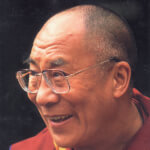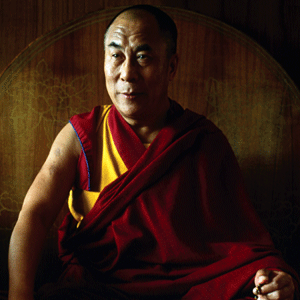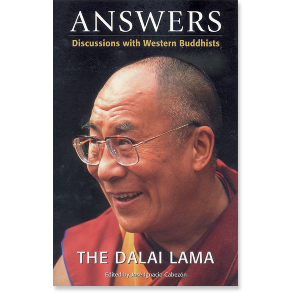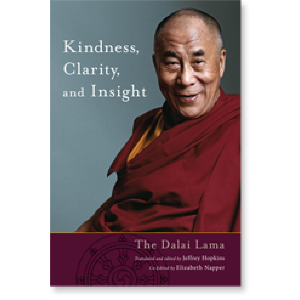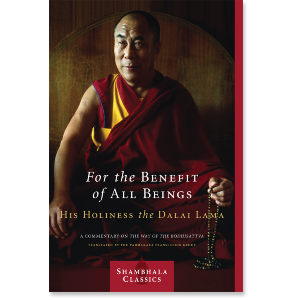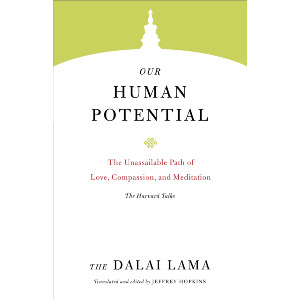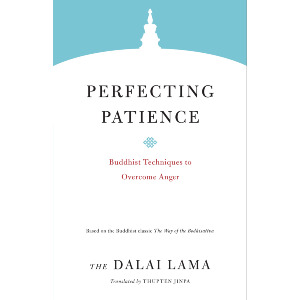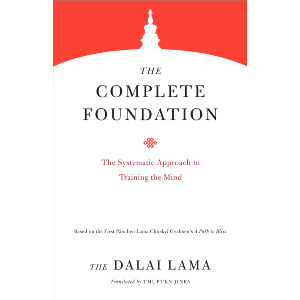| The following article is from the Summer, 2001 issue of the Snow Lion Newsletter and is for historical reference only. You can see this in context of the original newsletter here. |
"THIS IS A GREAT BOOK! The richness of this book lies in its simple spontaneity and breadth of subject matter." —The Tibet Journal
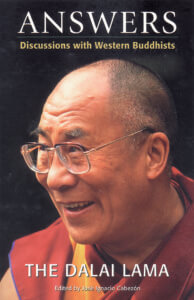
Discussions with Western Buddhists
By H.H. the Fourteenth Dalai Lama
Translated by Jose Cabezon
Edited by Jose Cabezon
When we come into contact with the followers of different religions, we should not argue. Instead, we should advise them to follow their own beliefs as sincerely and as truthfully as possible. For if they do so, they will no doubt reap certain benefits.
In India, at the place where the Buddha attained enlightenment, it became a well-established tradition for the Dalai Lama to spend several days each year giving teachings to Buddhists from all over the world.
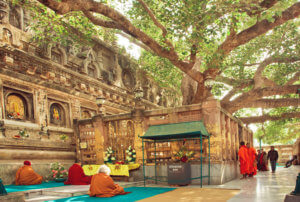
Following his teachings, he held informal group discussions with Western students of Buddhism. In these lively exchanges, the Dalai Lama exhibits clear and penetrating insight into issues that are most important to Western students.
Some of the topics discussed are: psychology, Christianity, being a practicing Buddhist in the West, spiritual teachers, reincarnation, emptiness, tantra, protector deities, liberation, meditation, compassion, disciplining others, the power of holy places, and retreats.
Jose Ignacio Cabezon holds the Dalai Lama XIV Chair in Tibetan Buddhism and Cultural Studies in the Religious Studies Department at the University of California, Santa Barbara and is the author of A Dose of Emptiness.
The following is an excerpt from the Editor's Introduction to "Answers":
Over the past several years, it has become a well established tradition for His Holiness the Dalai Lama to spend several days in January or February in residence in Bodhgaya. During this time, Buddhists from all over the world gather to listen to the teachings of His Holiness and to share in days of prayer and meditation.
Especially for the Tibetan Buddhists in exile, for the thousands who flock from Tibet for this occasion, and for the Indian Buddhists from the border areas of Ladakh, Kunu, Arunachal Pradesh and so forth, it is an opportunity not only to make pilgrimage to the place of the Buddha's enlightenment, to pray and to make prostrations under the Bodhi tree, and to circumambulate the central temple, it is an opportunity to engage in all of these practices during the visit of the Dalai Lama, who for them and for thousands of other Buddhists throughout the world, is a source of inspiration and the embodiment of living and active Buddhist principles.
these teachings. . . all share one common quality: that the questions asked are topical, the issues dealt with reflecting the current concerns of the participants, both Buddhist and non-Buddhist.
For the community of Western Buddhists as well, winter in Bodhgaya is a time for rejoicing, meeting old friends, and especially for practicing mental cultivation. Several meditation courses meet during this time, and there is usually some form of translation available for those who wish to attend the teachings of His Holiness. In addition, beginning in 1981, His Holiness has given group interviews to the Westerners.
Sometimes the discussions, which invariably have taken the form of question and answer sessions, were granted to groups at the close of a meditation retreat and were restricted to those who participated in that retreat (as in the case with the second discussion in this collection).
The majority of the meetings, however, were open to the general public. They were held, almost exclusively, in the Tibetan Temple in Bodhgaya.
Because of the spontaneous and dialogical nature of the interviews, they tended to differ in mood and content from year to year. Still, they all share one common quality: that the questions asked are topical, the issues dealt with reflecting the current concerns of the participants, both Buddhist and non-Buddhist.
It is enough that they are trying to become better human beings. This in itself is very good and worthy of praise.
In a very real way, the questions raised bring up problems that all of us face today. The range of topics is vast. We find philosophical discussions of the doctrine of emptiness, questions concerning the role of monks and nuns in the world today, and debates concerning particle physics, not to speak of questions dealing with politics, psychology, and Tantra.
In short, within these few pages, we find the entire gamut of religious and secular human concerns.
I myself was present at the first discussion and was the translator for the fourth. I have witnessed through the years the uniqueness of these occasions, and so, when I was approached to bring out that year's discussion in published form, I realized how worthwhile it would be to compile the Bodhgaya discussions in a single volume.
To this end, I have gone through tapes of all of the discussions, have scrutinized all portions in which His Holiness spoke in Tibetan to insure accuracy and to avoid the types of omissions to which spontaneous translation is heir. I have, of course, edited the entire text.
Nonetheless, with a view to preserving the original flavor of the dialogues as much as possible, I have tried to keep editing to a minimum.
Buddhists from all over the world gather to listen to the teachings of His Holiness and to share in days of prayer and meditation.
Here are some selected questions and answers from the book:
QUESTIONER: But aren't the objects of Tantric meditation just imaginary things without any reality?
HIS HOLINESS: Certainly, at the outset these objects are just mind-created.
In the beginning of the practice the various objects one realizes are simply imaginary. Nonetheless, they serve a special function and each has a specific purpose.
Their being imaginary does not deprive them of efficacy.
It is through the Tantric practice involving the most subtle consciousness that the goal of enlightenment can most quickly be realized.
Q: How do things exist if they are empty of inherent existence?
HIS HOLINESS: The doctrines of emptiness and selflessness do not imply the non-existence of things. Things do exist.
When we say that all phenomena are void of self-existence, it does not mean that we are advocating non-existence, that we are repudiating that things exist.
Then what is it we are negating? We are negating, or denying, that anything exists from its own side without depending on other things.
Hence, it is because things depend for their existence upon other causes and conditions that they are said to lack independent self-existence.
To put it another way, if we search for an object, subjecting it to logical analysis, it cannot be found. Whatever the object may be, whether it is mental or physical, whether it is nirvana or Sakyamuni Buddha himself, nothing can ever be found when it is searched for, when it is subjected to logical inquiry.
Now you see, we have this belief in an "I." We say, "I am so and so" or "I am a Buddhist."
The doctrines of emptiness and selflessness do not imply the non-existence of things. Things do exist.
If we investigate the implications of this, we cannot but conclude that the self, or "I," exists. Where there is a belief, there must be a believer, so there must be sentient beings. There is no question whether or not there exist beings—of course beings exist.
The Dalai Lama exists. Tibetans exist. There are Canadians and there are the English. Since England exists, there must be Englishmen, and an English language.
This is what we are speaking now. That there are beings who are at present speaking English is a fact which no one can deny.
But if we now ask ourselves, "where is this English which we are all speaking?," "where are the Englishmen?,' "where is the I'?," "where is the self of the Dalai Lama?"
We might be tempted to say that because no self is to be found when analyzed with logical reasoning, that there is no self at all. But this is wrong.
it is because things depend for their existence upon other causes and conditions that they are said to lack independent self-existence.
We can, for example, point to the Dalai Lama's physical form, his body, and we know that the Dalai Lama has a mind. My body and mind belong to me. So if I didn't exist at all, then how could "I" be the "owner' of my body and mind? How could they be "mine"? The body and mind belong to someone, and that someone is the "I."
It is because the body belongs to the self that, when we take an aspirin and the body feels better, we say, "I feel better." So it is because it is meaningful to say "I am not well" when the body is not well, it is because we sometimes get angry with ourselves when our mind forgets something and we say, "Oh, I'm so absent-minded," it is because all of these situations and forms of expression do occur and are meaningful, that we know there must exist a conventional, or nominal, "I."
Now, apart from the body and mind, there can be no "I," and yet, if we search for the self among our mental and physical aggregates, there is no "I" to be found. So the point is this:
there is an "I"
but it is something that is merely labeled in dependence upon
the body and mind.
Now the body itself is something which is material, and it is an entity composed of many parts, and it too, if searched for among those parts, cannot be found.
This applies equally to all phenomena, even to Maitreya Buddha himself. If we look for Maitreya Buddha among his aggregates, we cannot find even him. Since ultimately even Buddhas do not exist, we know that ultimately there can be no person, or self, of any kind.
However, conventionally, there is a Maitreya Buddha. His statue or image we can see for ourselves here in the temple. Now again, let us consider the image. It has different parts: the head, the torso, the hands, and feet. Apart from these there is no "image of Maitreya Buddha." The image is simply a composite of these different parts labeled by the name image of Maitreya Buddha.
So the conclusion is this:
if we investigate and search for any object,
we could spend years and years and never find it.
This means that the image of Maitreya, for example, does not exist from its own side.
It is something that is only labeled by our minds.
It does not exist inherently, and so it must be an entity only imputed, or labeled, by the mind.
Though the image does not ultimately exist, nonetheless, if we take the image as our object in visualization, for example, and worship it, etc., the merit is accrued and benefit will come.
it is through the use of the subtlest level of consciousness that the most powerful spiritual realizations can come about.
Q: Can you explain how Tantric meditation achieves the enlightened state so much more quickly than vipasyana, i.e. insight meditation?
HIS HOLINESS: In Tantric meditation, particularly in the practice of Anuttarayoga Tantra, while one is realizing emptiness, the ultimate truth, one controls thought through the use of certain techniques.
In the Sutrayana, the non-Tantric form of the Mahayana, there is no mention of these unique techniques involving the yogic practices of controlled breathing and meditation using the inner channels and chakras, etc. The Sutrayana just describes how to analyze the object, i.e. how to come to gain insight into the nature of the object through reasoning, etc.
The Anuttarayoga Tantra, however, teaches, in addition to this, certain techniques which use the channels, subtle winds, etc. to help one to control one's thoughts more effectively. These methods help one to more quickly gain control over the scattered mind and to achieve more effectively a level of consciousness which is at once subtle and powerful. This is the basis of the system.
there are rough levels of consciousness, more subtle levels, and then the innermost subtle level of consciousness.
The wisdom that realizes emptiness, that has gained insight into the nature of reality, is of varying kinds, depending upon the level of subtlety of the consciousness perceiving the emptiness.
In general, there are rough levels of consciousness, more subtle levels, and then the innermost subtle level of consciousness. It is the uncommon characteristic of Tantric practice that through it one can evoke this most subtle consciousness at will and put it to use in a most effective way.
For example, when emptiness is realized by this subtlest level of mind, it is more powerful, having a much greater effect on the personality.
meditations on the chakras and the channels (nadis), that one can control and temporarily abandon the rougher levels of consciousness.
In order to activate or make use of the more subtle levels of consciousness, it is necessary to block the rougher levels—the rougher or grosser levels must cease.
It is through specifically Tantric practices, such as the meditations on the chakras and the channels (nadis), that one can control and temporarily abandon the rougher levels of consciousness. When these become suppressed, the subtler levels of consciousness become active. And it is through the use of the subtlest level of consciousness that the most powerful spiritual realizations can come about.
Hence, it is through the Tantric practice involving the most subtle consciousness that the goal of enlightenment can most quickly be realized.
Different human beings have different mental predispositions, and there are cases when even Buddha himself could not do much to overcome these—there was a limit.
Q: It is generally said that teachers of other religions, no matter how great, cannot attain liberation without turning to the Buddhist path.
Now suppose there is a great teacher, say he is a Saivite, and suppose he upholds very strict discipline and is totally dedicated to other people all of the time, always giving himself. Is this person, simply because he follows Siva, incapable of attaining liberation, and if so, what can be done to help him?
HIS HOLINESS: During the Buddha's own time, there were many non-Buddhist teachers whom the Buddha could not help, for whom he could do nothing. So he just let them be.
The Buddha Sakyamuni was an extraordinary being, he was the manifestation, the nirmanakaya, or physical appearance, of an already enlightened being.
But while some people recognized him as a Buddha, other regarded him as a black magician with strange and evil powers. So, you see, even the Buddha Sakyamuni himself was not accepted as an enlightened being by all of his contemporaries.
The Buddha Sakyamuni was an extraordinary being, he was the manifestation, the nirmanakaya, or physical appearance, of an already enlightened being.
Different human beings have different mental predispositions, and there are cases when even Buddha himself could not do much to overcome these—there was a limit.
Now today, the followers of Siva have their own religious practices, and they reap some benefit from engaging in their own forms of worship. Through this, their life will gradually change.
Now my own position on this question is that Siva-ji's followers should practice according to their own beliefs and traditions, Christians must genuinely and sincerely follow what they believe, and so forth. That is sufficient.
When I meet the followers of different religions, I always praise them, for it is enough, it is sufficient, that they are following the moral teachings that are emphasized in every religion.
Q: But they will, not attain liberation.
HIS HOLINESS: We Buddhists ourselves will not be liberated at once. In our own case, it will take time.
Gradually, we will be able to reach moksa, or nirvana, but the majority of Buddhists will not achieve this within their own lifetimes. So there's no hurry.
If Buddhists themselves have to wait, perhaps many lifetimes, for their goal, why should we expect that it be different for non-Buddhists? So, you see, nothing much can be done.
Suppose, for example, you try to convert someone from another religion to the Buddhist religion, and you argue with them trying to convince them of the inferiority of their position. And suppose you do not succeed, suppose they do not become Buddhist. On the one hand, you have failed in your task, and on the other hand, you may have weakened the trust they have in their own religion, so that they may come to doubt their own faith. What have you accomplished by all this?
If Buddhists themselves have to wait, perhaps many lifetimes, for their goal, why should we expect that it be different for non-Buddhists?
It is of no use. When we come into contact with the followers of different religions, we should not argue. Instead, we should advise them to follow their own beliefs as sincerely and as truthfully as possible.
For if they do so, they will no doubt reap certain benefits. Of this there is no doubt. Even in the immediate future, they will be able to achieve more happiness and more satisfaction. Do you agree?
This is the way I usually act in such matters, it is my belief. When I meet the followers of different religions, I always praise them, for it is enough, it is sufficient, that they are following the moral teachings that are emphasized in every religion.
It is enough, as I mentioned earlier, that they are trying to become better human beings. This in itself is very good and worthy of praise.

